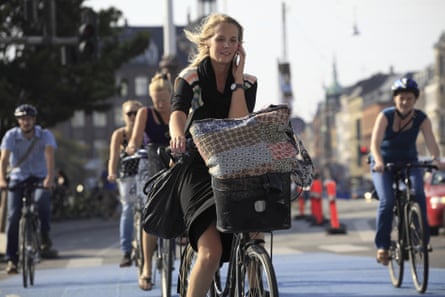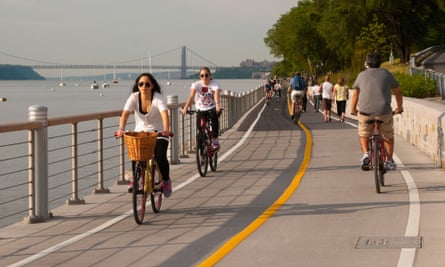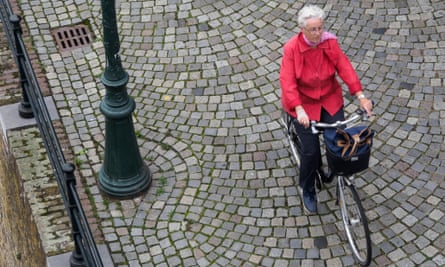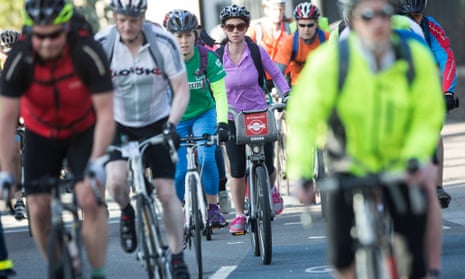As I wheel my clunky Santander bike out of the safety of the train station, I glance at my fellow cyclists waiting behind the red traffic light to cross the roundabout for Waterloo bridge. This is one of London’s most dangerous junctions for cyclists, and it is not reassuring to see that I am the only woman among five or six men, most of them in Lycra or high-vis jackets astride racing bikes.
The light turns green and they shoot off, leaving me breathing in diesel fumes behind a 171 bus, which pulls in to a stop as soon as it gets on to the bridge. I go around it, then get caught behind another bus that is signalling right to pull out. I stop to wait, catching my breath, and watch as another cyclist squeezes through the gap between the bus and a cement mixer in the next lane.
It feels as though you are taking your life in your hands if you are a cyclist in London – especially if you are a woman: of eight cyclists killed on London’s roads so far this year, six were female. The latest to die, 26-year-old Ying Tao, was hit by a tipper truck at the notorious Bank roundabout opposite the Bank of England on 22 June. Last month, Esther Hartsilver, a 32-year-old physiotherapist, was crushed by an HGV 100 metres from where she worked at King’s College Hospital. Other female fatalities this year were Stephanie Turner, a 29-year-old physiotherapist, Frederica Baldassa, a 26-year-old Italian fashion designer, 36-year-old Claire Hitier-Abadie of Marylebone, who was on a Santander bike, and designer Moira Gemmill, 55, killed on Lambeth Bridge. All were hit by lorries. The statistic is made all the more shocking because women make only 26% of cycling journeys in the capital.
Lilli Matson, head of surface delivery planning at Transport for London (TfL), says this year has been an anomaly: in all of 2014, there was only one woman among 13 fatalities, and for every billion kilometres cycled between 2008 and 2011, 710 men and 580 women were either killed or seriously injured. But she acknowledges that the overriding reason women only make up a quarter of London’s cyclists, despite a doubling in the number of people who commute by bike in the past decade or so, is because they fear for their safety.

London is not alone in lacking gender parity in cycling. Sustainable transport consultant Alix Stredwick quotes 2008 research by the Department for Transport showing that UK-wide, women make 27% of cycle journeys, just ahead of the US at 25%, but below Canada at 30% – and in a different league entirely to Germany at 49%, and Denmark and the Netherlands, where women cyclists outnumber men at around 55%. In many European cities, cycling is also a pursuit for all ages – unlike in UK cities, where it is mainly the preserve of young, fit and white males.
Stredwick says the gender imbalance in London “reflects the hostile road environment for cycling”. “I’ve come to the conclusion that we get the cyclists we deserve. If we have a street environment that’s hostile, that has no facilities, that has fast traffic with heavy lorries thundering past, we will get low numbers of courageous people, mainly men, on racing bikes and pretty well no one else. But if you provide a street environment where it’s much more egalitarian, where your granny can cycle to the shops safely and have somewhere to park her Dutch-style bike – that’s when we’ll get those kind of cyclists. But you have to be able to provide for them.”
Gil Penalosa, who runs Toronto-based consultancy 8-80 Cities, describes women cyclists as the “indicator species” for how bike-friendly a city is. “If there aren’t at least as many women as men, then usually it’s because cycling is not safe enough. It’s an indicator that you do not have good enough cycling infrastructure.”
This can be seen in New York, he points out, where on busy, traffic-clogged Manhattan streets, perhaps 80% of cyclists will be male, while along the five-mile segregated cycle path that runs along the Hudson River, more than half will be women.

For London, struggling to improve dangerously poor air quality amid increasing congestion, cycling is now being treated as a transport policy priority, a zero-emissions way to take pressure off the Underground and buses, which have seen passenger numbers double since 2001.
TfL wants to treble the number of journeys by bike in the city from 500,000 to 1.5m a day over the next decade, and double the number of people who cycle as part of their daily commute, transferring to bikes at mainline stations.
As Johnson says in the introduction to the Mayors Vision for Cycling in London, “Our routes will specifically target parts of the tube and bus network which are over capacity, promoting transfers to bikes and relieving crowding for everyone. Cycling will transform more of our city into a place dominated by people, not motor traffic.” But he says this will only come about when people feel comfortable doing it in ordinary clothes, astride clunky bikes. “I want more women cycling, more older people cycling, more black and minority ethnic Londoners cycling, more cyclists of all social backgrounds – without which truly mass participation can never come.”
Matson says improving safety is the main thrust of London’s £913m cycling drive, with a grid of high quality cycle routes crisscrossing the city, using a combination of segregated cycle ways – including the east-west cycling superhighway – and quieter back-route streets that will be well signposted and prioritise cyclists. There are also similar schemes, called “mini Hollands”, being developed in the outer London boroughs of Kingston, Walthamstow and Enfield.
Safety isn’t exclusively a female concern, she says, but “it is clear that women give safety a much higher priority than men, so we have to have the right kind of infrastructure that’s attractive to them”. She points out that there are also plans to step up efforts to tackle the dangers posed by HGVs.

Rachel Aldred, senior lecturer in transport at the University of Westminster, says London’s plans are “a big step forward”. But she is not convinced that they will bring about the cycling revolution on London’s streets that the mayor envisages.
“They are still not planning the kind of dense, direct network that you will see in many Dutch and Danish towns. It needs to be a much denser network than they’re planning at the moment – one where you don’t have one superhighway but a whole network of high quality routes that you don’t have to share with all that motor traffic.”
She says that TfL’s budget for cycling over the next decade, which works out to around £11 per person per year, is half of what some cities in the Netherlands and Denmark spend. “And they already have good infrastructure. Eleven pounds is much better than we’ve had in the past, but when you consider that we have to catch up, it won’t transform things over night.”
And while women are an important demographic to target, cycle infrastructure needs to be planned with children and old people in mind as well, Aldred says. She points to a 2010 TfL study, Analysis of Cycle Potential in London, which excludes over-65s as potential cyclists.
In Cambridge, which is unique in the UK in having European levels of cycling commuters at 32.5% (compared to about 7.2% in inner London and 3% UK-wide), not only is there gender parity, but a quarter of over-65s cycle-commute. “It’s a big mistake to exclude over-65s. We need them if we are to get those higher levels of cycling.”
The same goes for children, she says. Only 2-3% of children in the UK cycle to school, compared with 49% of Dutch school children. And since women are mainly responsible for the school run, not being able to cycle children to school and then continue on to work has big implications for traffic congestion at school-run time.
“From my research, a lot of people might cycle in a bus lane but they wouldn’t want to do that with an eight-year-old child. You need to have quality cycle routes along main roads with plenty of room. You want your person in Lycra to be able to overtake a kid going to school.”
The Cambridge core traffic scheme, which restricts car use in the city centre and prioritises cycling and public transport, is the main reason cycling rates in that city are so high, says Aldred.
Bold measures to promote cycling at the expense of other modes of traffic may be needed in London, too, Stredwick suggests. “What politicians are nervous about tackling is the fact that it’s not just about cycling. It’s about how it affects other modes [of transport],” she says.
Where Stredwick lives, in the inner London borough of Hackney, 15% of commuters now cycle, double the inner London average, but the share of women cyclists is little improved, she says. She puts this partly down to the council’s resistance to segregate bike lanes on main roads, for fear that they will interfere with bus travel and car parking spaces.
“Maybe we need fewer buses, pumping out diesel particulates. People could get off the buses and cycle instead.”

Comments (…)
Sign in or create your Guardian account to join the discussion